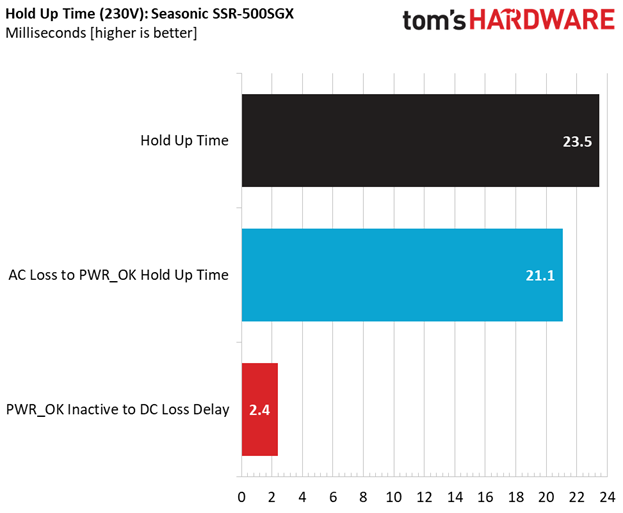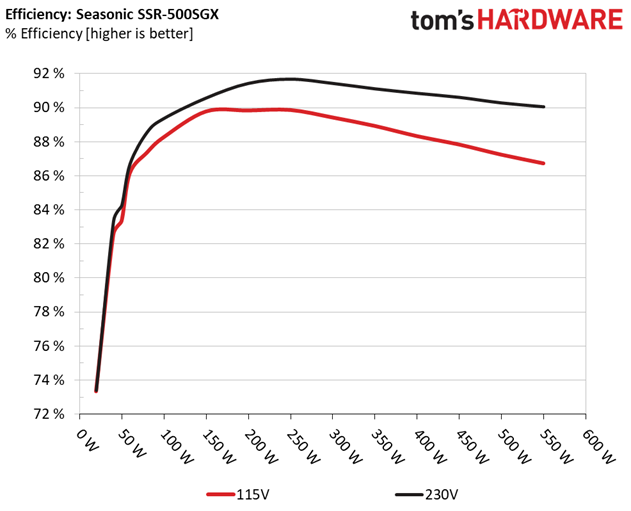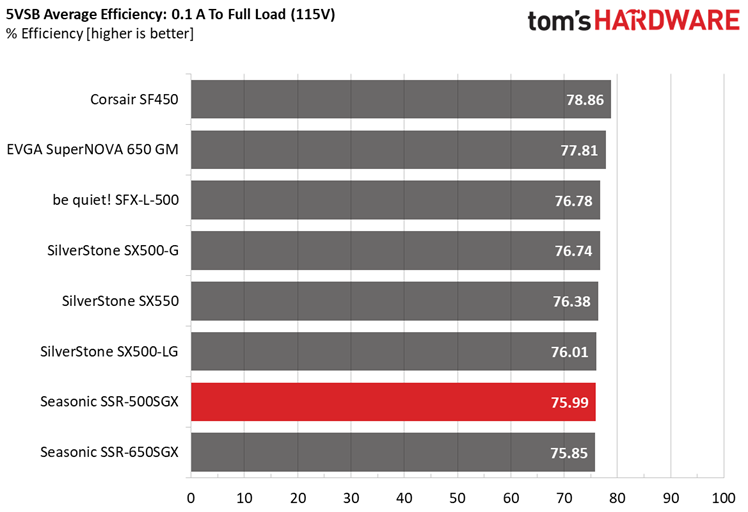Seasonic Focus SGX 500W SFX-L Power Supply Review: Top Performance In A Small Package
Why you can trust Tom's Hardware
Load Regulation, Hold-Up Time, Inrush Current, Efficiency and Noise
To learn more about our PSU tests and methodology, please check out How We Test Power Supply Units.
Primary Rails and 5VSB Load Regulation
The following charts show the main rails' voltage values recorded between a range of 40W up to the PSU's maximum specified load, along with the deviation (in percent). Tight regulation is an important consideration every time we review a power supply, because it facilitates constant voltage levels despite varying loads. Tight load regulation also, among other factors, improves the system’s stability, especially under overclocked conditions and, at the same time, it applies less stress to the DC-DC converters that many system components utilize.








The load regulation is extra tight on all rails, providing an example to follow to all competing models.
Hold-Up Time
Put simply, hold-up time is the amount of time that the system can continue to run without shutting down or rebooting during a power interruption.







The hold time is long and the power ok signal is accurate. There is nothing more to ask here.
Inrush Current
Inrush current, or switch-on surge, refers to the maximum, instantaneous input current drawn by an electrical device when it is first turned on. A large enough inrush current can cause circuit breakers and fuses to trip. It can also damage switches, relays, and bridge rectifiers. As a result, the lower the inrush current of a PSU right as it is turned on, the better.


The registered inrush currents are at normal levels.
Get Tom's Hardware's best news and in-depth reviews, straight to your inbox.
10-110% Load Tests
These tests reveal the SSR-500SGX’s load regulation and efficiency levels under high ambient temperatures. They also show how the fan speed profile behaves under increased operating temperatures.
| Test # | 12V | 5V | 3.3V | 5VSB | DC/AC (Watts) | Efficiency | Fan Speed (RPM) | PSU Noise (dB[A]) | Temps (In/Out) | PF/AC Volts |
|---|---|---|---|---|---|---|---|---|---|---|
| 1 | 2.333A | 2.000A | 1.984A | 0.975A | 49.518 | 83.324% | 0 | <6.0 | 43.89°C | 0.934 |
| 11.973V | 4.999V | 3.320V | 5.128V | 59.428 | 39.40°C | 115.09V | ||||
| 2 | 5.739A | 3.002A | 2.980A | 1.172A | 99.611 | 88.256% | 0 | <6.0 | 44.38°C | 0.972 |
| 11.975V | 4.996V | 3.318V | 5.119V | 112.866 | 39.75°C | 115.09V | ||||
| 3 | 9.480A | 3.503A | 3.465A | 1.370A | 149.523 | 89.764% | 0 | <6.0 | 45.16°C | 0.981 |
| 11.976V | 4.995V | 3.317V | 5.110V | 166.574 | 40.07°C | 115.08V | ||||
| 4 | 13.223A | 4.004A | 3.980A | 1.568A | 199.550 | 89.821% | 939 | 19.8 | 40.60°C | 0.985 |
| 11.976V | 4.994V | 3.316V | 5.101V | 222.163 | 45.94°C | 115.09V | ||||
| 5 | 16.630A | 5.007A | 4.976A | 1.768A | 249.682 | 89.851% | 1014 | 23.2 | 41.18°C | 0.988 |
| 11.977V | 4.994V | 3.315V | 5.093V | 277.886 | 46.78°C | 115.09V | ||||
| 6 | 20.034A | 6.007A | 5.973A | 1.967A | 299.761 | 89.414% | 1338 | 33.2 | 41.95°C | 0.987 |
| 11.978V | 4.993V | 3.315V | 5.084V | 335.249 | 47.87°C | 115.09V | ||||
| 7 | 23.441A | 7.010A | 6.969A | 2.168A | 349.889 | 88.914% | 1489 | 36.7 | 42.31°C | 0.988 |
| 11.979V | 4.992V | 3.314V | 5.074V | 393.514 | 48.36°C | 115.09V | ||||
| 8 | 26.851A | 8.016A | 7.966A | 2.370A | 400.017 | 88.317% | 1797 | 41.5 | 42.71°C | 0.989 |
| 11.978V | 4.990V | 3.313V | 5.065V | 452.931 | 48.86°C | 115.09V | ||||
| 9 | 30.657A | 8.523A | 8.452A | 2.373A | 449.759 | 87.826% | 2028 | 44.1 | 43.11°C | 0.990 |
| 11.979V | 4.989V | 3.312V | 5.059V | 512.105 | 49.77°C | 115.12V | ||||
| 10 | 34.231A | 9.024A | 8.971A | 2.975A | 499.788 | 87.232% | 2082 | 44.1 | 44.26°C | 0.991 |
| 11.980V | 4.987V | 3.310V | 5.043V | 572.942 | 51.03°C | 115.13V | ||||
| 11 | 38.404A | 9.027A | 8.971A | 2.978A | 549.815 | 86.720% | 2084 | 44.1 | 46.09°C | 0.992 |
| 11.981V | 4.986V | 3.309V | 5.038V | 634.013 | 53.27°C | 115.12V | ||||
| CL1 | 0.140A | 12.000A | 11.998A | 0.000A | 101.367 | 83.622% | 1245 | 31.4 | 41.74°C | 0.973 |
| 11.977V | 4.995V | 3.313V | 5.124V | 121.220 | 46.13°C | 115.18V | ||||
| CL2 | 41.008A | 1.004A | 0.997A | 1.000A | 504.765 | 88.169% | 2089 | 44.1 | 44.76°C | 0.991 |
| 11.982V | 4.992V | 3.317V | 5.088V | 572.496 | 51.15°C | 115.10V |
The unit meets the 80 PLUS Gold requirements with 20% and 100% of the max-rated load, while it is a little lower than the required 90% at full load. Nonetheless, we conduct our tests at much higher ambient temperatures than the 80 PLUS organization, so it is normal to measure lower efficiency levels.
20-80W Load Tests
In the following tests, we measure the SSR-500SGX's efficiency at loads significantly lower than 10 percent of its maximum capacity (the lowest load the 80 PLUS standard measures). This is important for representing when a PC is idle, with power-saving features turned on.
| Test # | 12V | 5V | 3.3V | 5VSB | DC/AC (Watts) | Efficiency | Fan Speed (RPM) | PSU Noise (dB[A]) | PF/AC Volts |
|---|---|---|---|---|---|---|---|---|---|
| 1 | 1.194A | 0.499A | 0.477A | 0.194A | 19.373 | 73.341% | 0 | <6.0 | 0.816 |
| 11.967V | 5.008V | 3.326V | 5.146V | 26.415 | 115.08V | ||||
| 2 | 2.466A | 0.997A | 0.989A | 0.389A | 39.796 | 82.532% | 0 | <6.0 | 0.919 |
| 11.971V | 5.004V | 3.324V | 5.140V | 48.219 | 115.08V | ||||
| 3 | 3.668A | 1.499A | 1.471A | 0.584A | 59.298 | 86.131% | 0 | <6.0 | 0.949 |
| 11.973V | 5.001V | 3.321V | 5.135V | 68.846 | 115.08V | ||||
| 4 | 4.936A | 2.000A | 1.987A | 0.780A | 79.698 | 87.354% | 0 | <6.0 | 0.962 |
| 11.974V | 4.999V | 3.320V | 5.129V | 91.236 | 115.08V |
In all four light-load tests, the cooling fan is not engaged, so the PSU's operation is inaudible.
Efficiency
Next, we plotted a chart showing the SSR-500SGX’s efficiency at low loads, and loads from 10 to 110 percent of its maximum-rated capacity. The higher a PSU’s efficiency the less energy goes wasted leading to a reduced carbon footprint, besides lower electricity bills.




The SSR-500SGX achieves satisfactory efficiency levels under both normal and light loads.
5VSB Efficiency
| Test # | 5VSB | DC/AC (Watts) | Efficiency | PF/AC Volts |
|---|---|---|---|---|
| 1 | 0.100A | 0.515 | 73.994% | 0.109 |
| 5.151V | 0.696 | 115.10V | ||
| 2 | 0.250A | 1.287 | 76.380% | 0.222 |
| 5.148V | 1.685 | 115.09V | ||
| 3 | 0.550A | 2.829 | 77.528% | 0.335 |
| 5.143V | 3.649 | 115.09V | ||
| 4 | 1.000A | 5.136 | 77.560% | 0.403 |
| 5.136V | 6.622 | 115.09V | ||
| 5 | 1.500A | 7.692 | 77.799% | 0.437 |
| 5.127V | 9.887 | 115.09V | ||
| 6 | 3.000A | 15.290 | 76.032% | 0.481 |
| 5.096V | 20.110 | 115.08V |


The 5VSB rail should be more efficient.
Power Consumption In Idle and Standby
| Mode | 12V | 5V | 3.3V | 5VSB | Watts | PF/AC Volts |
|---|---|---|---|---|---|---|
| Idle | 11.967V | 5.009V | 3.326V | 5.152V | 5.097 | 0.459 |
| 115.1V | ||||||
| Standby | 0.045 | 0.008 | ||||
| 115.1V |


Fan RPM, Delta Temperature, and Output Noise
All results are obtained between an ambient temperature of 36 degrees Celsius (96.8 degrees Fahrenheit) to 46 degrees Celsius (114.8 degrees Fahrenheit).
The fan profile could be less aggressive under high operating temperatures. In our tests, the PSU's fan spins at higher than 2000 RPM, with more than 450W load at at >43°C temperatures.
The following results were obtained at 30 degrees Celsius (86 degrees Fahrenheit) to 32 degrees Celsius (89.6 degrees Fahrenheit) ambient temperature.
The passive operation lasts up to 150W on the +12V rail even with full, combined, load on the minor rails. The unit enters the 40-45 dB(A) range (comparative noise example: library, bird calls) with close to 400W loads. Given the high enough efficiency levels, the fan profile should be more relaxed under high loads.
MORE: Best Power Supplies
MORE: How We Test Power Supplies
MORE: All Power Supply Content
Current page: Load Regulation, Hold-Up Time, Inrush Current, Efficiency and Noise
Prev Page Specifications and Part Analysis Next Page Protection Features, DC Power Sequencing, Cross-Load Tests and Infrared Images
Aris Mpitziopoulos is a contributing editor at Tom's Hardware, covering PSUs.






